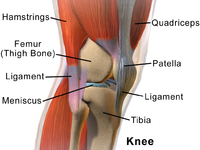
Photo from wikipedia
AIM To study the development of early knee osteoarthritis (OA) in subjects with and without risk factors for knee OA. METHODS We studied 340 subjects from the Osteoarthritis Initiative (OAI),… Click to show full abstract
AIM To study the development of early knee osteoarthritis (OA) in subjects with and without risk factors for knee OA. METHODS We studied 340 subjects from the Osteoarthritis Initiative (OAI), aged 45-55 years (51% women), free of radiographic knee OA at baseline (n = 294 with and n = 46 without knee pain and other OA risk factors). At baseline, 24, 48, 72 and 96 months we compared the two groups for prevalence and overlap of knee OA as defined by magnetic resonance imaging (MRI-based OA), x-rays (Kellgren-Lawrence grade [KLG] ≥ 1), and pain, using a logistic mixed model. We studied the group differences (%) over time by subtracting the OA prevalence of those without risk factors from the group with risk factors. RESULTS The group with OA risk factors had higher proportions of MRI-based OA than the group without OA risk factors at all visits, but the difference diminished at 72 months (72 months difference = 11.9%, 95% confidence intervals [CI] = -2.3-26.1). Further, at 72 months, the presence of KLG ≥ 1 were similar in the two groups (-3.5%, 95% CI = -15.2-8.2). The proportion fulfilling all three OA definitions was 1.7% at 24 months and 4.8% at 72 months of those with OA risk factors and 0% and 2.2%, respectively, in those without. CONCLUSION Structural changes of the knee are common irrespective of the presence of pain or other OA risk factors. Such structural changes in absence of knee symptoms should probably be considered as risk factors for early OA rather than disease.
Journal Title: Osteoarthritis and cartilage
Year Published: 2018
Link to full text (if available)
Share on Social Media: Sign Up to like & get
recommendations!